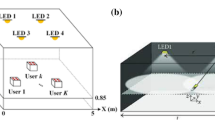Abstract
This paper proposes generalized frequency division multiplexing (GFDM) for indoor visible light communication (VLC). GFDM is a flexible multi-carrier scheme that allows engineering in both time and frequency domain, therefore, making GFDM suitable for various 5G applications. In the literature, different types of optical orthogonal frequency division multiplexing (O-OFDM) have been proposed for VLC including direct current offset optical OFDM (DCO-OFDM), asymmetrically clipped optical OFDM (ACO-OFDM), Flip-OFDM, etc. O-OFDM can provide high data rate, but it suffers from the problem of the high peak-to-average power ratio (PAPR) which causes clipping distortion, reduces the illumination-to-communication conversion efficiency and affects the lifetime of the LED. The proposed optical GFDM (O-GFDM) scheme for VLC is analyzed for various performance metrics against the O-OFDM counterpart. The analytical expression for symbol error rate (SER) of O-GFDM is derived and simulation results based on PAPR, SER and subcarrier frequency shift tolerance validate the improved performance of the proposed O-GFDM scheme. It is found that one of the variants of the proposed scheme has better spectral efficiency and lower power consumption compared with O-OFDM counterpart. As GFDM is being considered for 5G wireless systems, it is expected that the GFDM-based VLC system will very well gel with next-generation wireless systems to offer seamless services and will provide greater flexibility using software-defined networking.








Similar content being viewed by others
References
Pathak, P.H., Feng, X., Hu, P., Mohapatra, P.: Visible light communication, networking, and sensing: a survey, potential and challenges. IEEE Commun. Surv. Tutor. 17(4), 2047–2077 (2015)
Karunatilaka, D., Zafar, F., Kalavally, V., Parthiban, R.: LED based indoor visible light communications: state of the art. IEEE Commun. Surv. Tutor. 17(3), 1649–1678 (2015)
Fernando, N., Hong, Y., Viterbo, E.: Flip-OFDM for optical wireless communications. In: Information Theory Workshop (ITW), pp. 5–9. IEEE (2011)
Armstrong, J., Schmidt, B.J.: Comparison of asymmetrically clipped optical OFDM and DC-biased optical OFDM in AWGN. IEEE Commun. Lett. 12(5), 343–345 (2008)
Michailow, N., Matthé, M., Gaspar, I.S., Caldevilla, A.N., Mendes, L.L., Festag, A., Fettweis, G.: Generalized frequency division multiplexing for 5th generation cellular networks. IEEE Trans. Commun. 62(9), 3045–3061 (2014)
Wu, J., Ma, X., Qi, X., Babar, Z., Zheng, W.: Influence of pulse shaping filters on PAPR performance of underwater 5G communication system technique: GFDM. Wirel. Commun. Mobile Comput. (2017)
Michailow, N., Fettweis, G.: Low peak-to-average power ratio for next generation cellular systems with generalized frequency division multiplexing. In: 2013 International Symposium on Intelligent Signal Processing and Communication Systems, pp. 651–655. IEEE (2013)
Sharifian, Z., Omidi, M.J., Saeedi-Sourck, H., Farhang, A.: Linear precoding for PAPR reduction of GFDMA. IEEE Wirel. Commun. Lett. 5(5), 520–523 (2016)
Wunder, G., Jung, P., Kasparick, M., Wild, T., Schaich, F., Chen, Y., Ten Brink, S., Gaspar, I., Michailow, N., Festag, A., et al.: 5GNOW: non-orthogonal, asynchronous waveforms for future mobile applications. IEEE Commun. Mag. 52(2), 97–105 (2014)
Saljoghei, A., Farhang, A., Browning, C., Perry, P., Marchetti, N., Doyle, L.E., Barry, L.P.: Comparison of OFDMA and GFDMA for next-generation pons. J. Opt. Commun. Netw. 9(12), 1064–1073 (2017)
Tian, F., Guo, D., Liu, B., Zhang, Q., Tian, Q., Ullah, R., Xin, X.: A novel concatenated coded modulation based on GFDM for access optical networks. IEEE Photon. J. 10(2), 1–8 (2018)
Delmade, A., Browning, C., Farhang, A., Marchetti, N., Doyle, L. E., Koilpillai, D., Barry, L.P., Venkitesh, D.: Performance analysis of optical front-hauling for 5G waveforms. In: Lasers and Electro-Optics Europe & European Quantum Electronics Conference, p. 1. IEEE (2017)
Maheswari, S., Srivastava, A.: Comparative study of various modulation schemes used in indoor VLC (2017). https://repository.iiitd.edu.in/jspui/handle/123456789/549
Alves, B.M., Mendes, L.L., Guimaraes, D.A., Gaspar, I.S.: Performance of GFDM over frequency-selective channels-invited paper. In: Proceedings of International Workshop on Telecommunications (2013)
Fettweis, G., Krondorf, M., Bittner, S.: GFDM-generalized frequency division multiplexing. In: Vehicular Technology Conference, pp. 1–4. IEEE (2009)
Michailow, N., Krone, S., Lentmaier, M., Fettweis, G.: Bit error rate performance of generalized frequency division multiplexing. In: Vehicular Technology Conference (VTC Fall), pp. 1–5. IEEE (2012)
Barry, J.R., Kahn, J.M., Krause, W.J., Lee, E.A., Messerschmitt, D.G.: Simulation of multipath impulse response for indoor wireless optical channels. IEEE J. Sel. Areas Commun. 11(3), 367–379 (1993)
Komine, T., Nakagawa, M.: Performance evaluation of visible-light wireless communication system using white LED lightings. In: Ninth International Symposium on Computers and Communications, 2004. Proceedings. ISCC 2004, vol. 1, pp. 258–263. IEEE (2004)
Chen, L., Krongold, B., Evans, J.: Performance analysis for optical OFDM transmission in short-range IM/DD systems. J. Lightwave Technol. 30(7), 974–983 (2012)
Fernando, N., Hong, Y., Viterbo, E.: Flip-OFDM for unipolar communication systems. IEEE Trans. Commun. 60(12), 3726–3733 (2012)
Farhang, A., Marchetti, N., Doyle, L.E.: Low-complexity modem design for GFDM. IEEE Trans. Signal Process. 64(6), 1507–1518 (2016)
Afgani, M.Z., Haas, H., Elgala, H., Knipp, D.: Visible light communication using OFDM. In: 2nd International Conference on Testbeds and Research Infrastructures for the Development of Networks and Communities, 2006. TRIDENTCOM 2006, p. 6. IEEE (2006)
Qiu, Y., Chen, H.-H., Meng, W.-X.: Channel modeling for visible light communicationsa survey. Wirel. Commun. Mobile Comput. 16(14), 2016–2034 (2016)
Choi, J.-H., Lim, B.-J., Kim, Y.-J., Ko, Y.-C.: Effect of timing and frequency synchronization errors on GFDM systems. In: Information and Communication Technology Convergence (ICTC), pp. 1322–1325. IEEE (2015)
Truong, T.-A., Arzel, M., Lin, H., Jahan, B., Jezequel, M.: DFT precoded OFDM an alternative candidate for next generation PONs. J. Lightwave Technol. 32(6), 1228–1238 (2014)
Acknowledgements
The authors would like to thank Intel (R) India for funding the Ph.D. fellowship program.
Author information
Authors and Affiliations
Corresponding authors
Additional information
Publisher's Note
Springer Nature remains neutral with regard to jurisdictional claims in published maps and institutional affiliations.
Rights and permissions
About this article
Cite this article
Ahmad, R., Srivastava, A. Optical GFDM: an improved alternative candidate for indoor visible light communication. Photon Netw Commun 39, 152–163 (2020). https://doi.org/10.1007/s11107-019-00877-5
Received:
Accepted:
Published:
Issue Date:
DOI: https://doi.org/10.1007/s11107-019-00877-5




